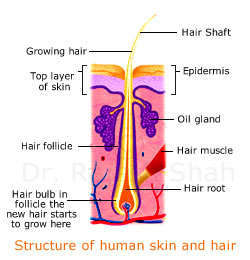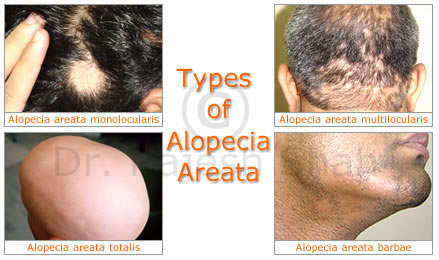What is Alopecia Areata?
Alopecia Areata ('baldness in spots') is a form of hair loss, usually from the scalp, although it can affect other areas of the body. The hair loss mostly remains limited to the scalp but in certain cases, it can extend to eyebrows, eyelashes, facial hair (beard, mustache), nasal hair and give rise to bald spots anywhere in the body. Alopecia Areata is a common condition which arises largely due to a mix of immunological and hormonal factors.
Alopecia Areata can affect both men and women and it is not uncommon to see children affected by this disorder. Approximately 2% of the general population worldwide suffers from Alopecia Areata. We come across many children with Alopecia Areata.
Understanding Alopecia Areata:
The hair is made up of a protein called keratin which is also the main constituent of nails. A specialized structure of the skin called ‘Papilla' produces the hair as shown in the figure. The papilla is surrounded by a sac-like structure called the ‘Hair follicle' which also surrounds rest of the hair root within the skin. The part of the hair outside the skin surface is called a shaft.
 Alopecia Areata is considered to be an auto-immune condition in which the immune system of the body (which protects the body from bacteria and viruses) mistakenly attacks the hair follicles and destroys them. This leads to hair loss in the affected area.
Alopecia Areata is considered to be an auto-immune condition in which the immune system of the body (which protects the body from bacteria and viruses) mistakenly attacks the hair follicles and destroys them. This leads to hair loss in the affected area.
The commonest presentation of Alopecia Areata is the appearance of bald patches on the scalp. In most cases, hair falls out in small, round patches about the size of a small coin. The patient may have single or multiple such patches. In some cases, these patches may remain static, whereas in some cases the patches may spread to involve larger areas of the scalp. In some cases, hair loss is more extensive. Although it is not very common, the disease can progress to cause total loss of hair on the head (Alopecia Areata totalis) or complete loss of hair on the head, face, and rest of the body (Alopecia Areata Universalis).
Types of Alopecia Areata:

- Alopecia Areata monolocularis:
In this condition, there is a single bald spot on the scalp.
- Alopecia Areata multilocularis:
In this condition, there are multiple bald spots on the scalp.
- Alopecia Areata totalis:
In this condition, the patient loses all the hair on the scalp.
- Alopecia Areata universalis:
In this condition, all body hair, including pubic hair, is lost.
- Alopecia Areata barbae:
In this condition, the disease is limited only to the beard region.
Traction alopecia:
In this condition, alopecia develops along the frontal margins and temporal margins of the scalp due to constant tension on the hair from being tied very tightly.
It is important for all cases of Alopecia Areata to rule out two conditions, which often accompany: 1. Underactive Thyroid (Hypothyroidism) 2. Diabetes Mellitus
All three of them are auto-immune diseases and their treatment and prognosis is dependent on control of all of them at the same time, as observed in a large number of cases treated at Life Force.
Written & Approved by-
Dr. Rajesh Shah
M.D. (Hom.)